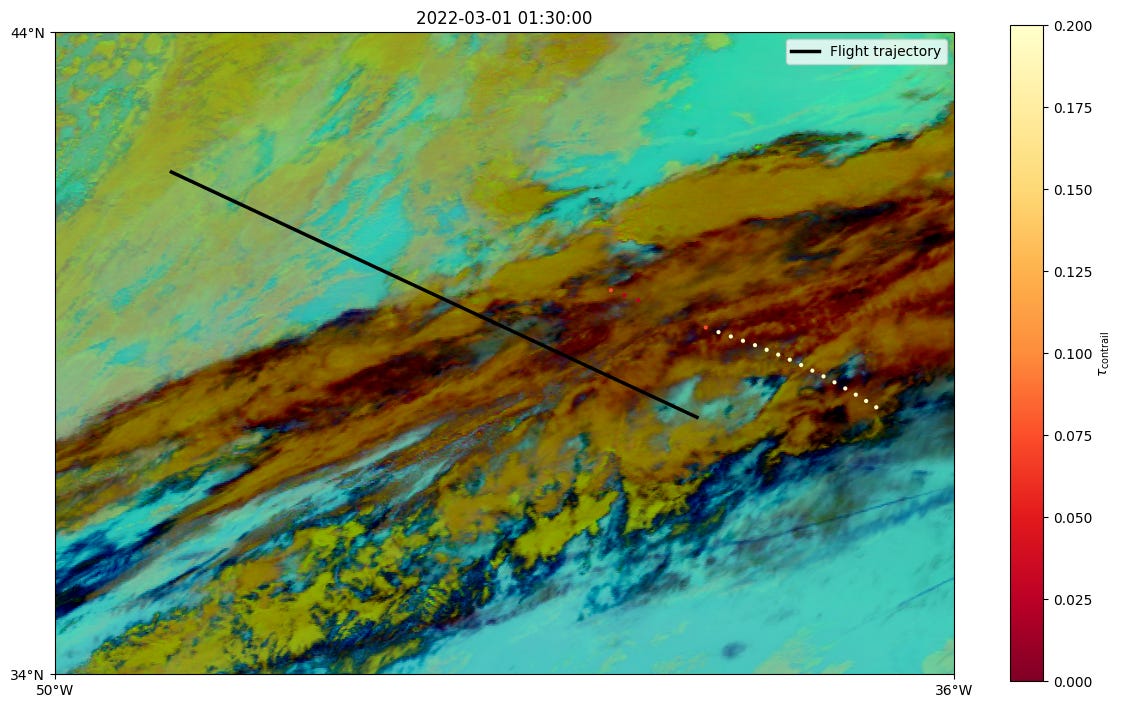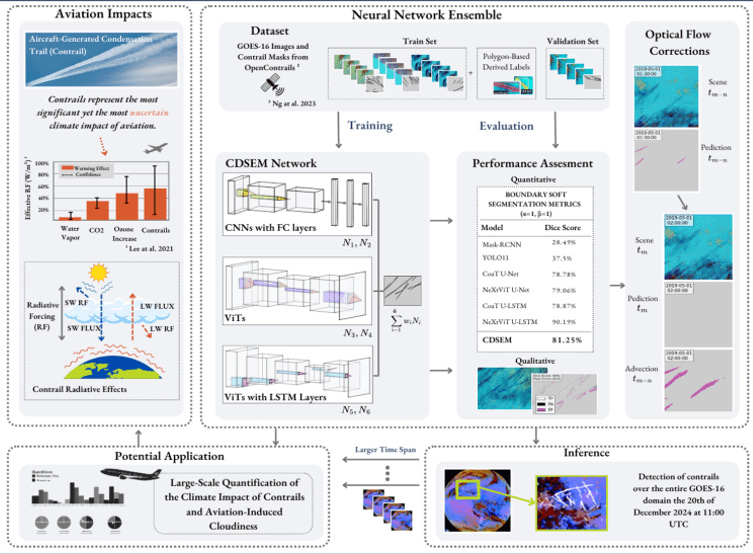Introducing the Contrail Detection and Segmentation Ensemble Model
The Latest AI-Based Tool for Identifying Aviation-Induced Contrails
One of the key challenges thus far in the quest to quell contrails has been the process of accurately identifying them. At Google, for example, teams of researchers spent hundreds of hours combing through tens of thousands of satellite images in an effort to detect and label aviation-induced contrails. Their work, utilizing the GOES-16, helped to build data sets which have allowed Google to train a state-of-the-art computer vision model to detect contrail formation within 30 minutes. Models like this are crucial to advancing our understanding of how contrails form, how they disperse throughout the atmosphere, and how they impact the environment.
Speaking of Models
Until now, three models have been most prevalent when quantifying aviation’s climate effects: 1) the Algorithmic Climate Change Functions (aCCFs) 2) the Contrail Cirrus Prediction Tool (CoCiP) and 3) the Aircraft Plume Chemistry, Emissions, and Microphysics Model (APCEMM).
ACCFs, as explained in this presentation at the Sustainable Skies Conference, characterize the climate impact of non-CO2 aviation emissions at a specific location and time. These climate functions are based on meteorological parameters and are calculated from numerical weather prediction data. ACCFs can be provided, through mathematical formulae, for contrail-cirrus, water vapor, and NOx-induced changes to ozone and methane.
CoCiP, which also relies on meteorological inputs, differs from aCCFs in that it focuses entirely on contrails. In the same presentation referenced above, the contrail prediction tool is described as a “fast, parameterized model of contrail formation, lifecycle and properties.” Instead of mathematical formulae, CoCiP requires a Lagrangian plume model which is able to track the nascent contrail as it is carried by the winds, following its trajectory.
Then there is APCEMM. This model, described in a 2020 study focuses on a single aircraft plume, simulating its chemistry and physics throughout its evolution. APCEMM looks at a variety of conditions to ascertain the influence of changes in environment, aircraft characteristics, and fuel properties on in-plume chemistry and the distribution of aerosols (whether the contrail will expand to be persistent or not). The tool was developed to bridge the gaps between previous simulations and models, yet still has its uncertainties.
A quandary with these models is the persistent uncertainties which reduce confidence in the determination of climate impacts. The accuracy of the meteorological forecasts and estimated aircraft emissions are two of the main sources of uncertainty which bolster the complexity of modelling the radiative properties of contrails, their movements in the atmosphere, and the magnitude of their effect on the climate. As such, a multi-model framework could be the next step to address the limitation of the previous models and improve the accuracy of tracking contrails. Enter, the Contrail Detection and Segmentation Ensemble Model (CDSEM).
The New Model in Town
Earlier this week, it was announced that a new tool has been introduced for more accurately tracking individual linear contrails and their evolution. The Contrail Detection and Segmentation Ensemble Model (CDSEM) harnesses six neural networks trained on the OpenContrails dataset for improved precision and instance segmentation. CDSEM was fine-tuned during a study (preprint) led by Irene Ortiz, seeking to enhance the detection of contrails to better understand their full climate impact.
The study, funded by the SESAR Joint Undertaking, found that the CDSEM identifies contrail features with 93% accuracy, while detecting false positives less than 3% of the time. Previously, the possibility of false positives has been a large hurdle for contrail trials and simulations, so this data can help clear up some of the guess work involved in contrail avoidance. Though useful, the CDSEM was initially found to have limitations which needed to be addressed in the study:
Specifically, the two primary challenges limiting enhanced performance are as follows: first, the imprecise delineation of contrail boundaries in the provided labels skew the evaluation of the model’s true performance; and second, the underrepresentation and lack of labels for aged, diffuse contrails in the training data limit the model’s ability to identify contrail-cirrus clouds, thereby restricting its applicability in real-world contrail impact assessments to only young, linear contrails.
The purpose of the study was to ascertain these shortcomings and increase the quality of output from the CDSEM. Mission accomplished. By utilizing the Boundary Soft framework, the researchers were able to address the challenge of imprecise contrail boundaries and enhance the performance of the CDSEM. Furthermore, the study improved upon the applicability of the data by proposing the Optical Flow Correction (OFC) algorithm which augmented the model’s ability to detect a broader range of contrail types and coverages.
As the challenges and limitations to real-world application of contrail identification and detection are addressed and resolved, the journey toward contrail management can proceed with much more confidence. The CDSEM is a fine addition to the arsenal of models clarifying uncertainties and quantifying aviation’s non-CO2 effects.








